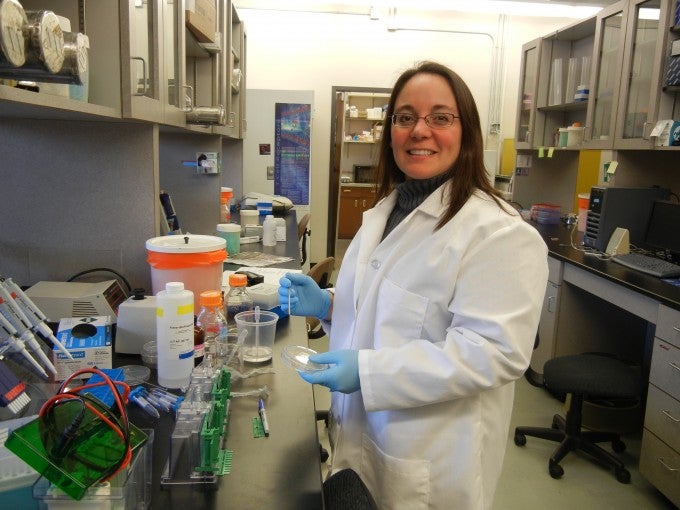
Professor, Department of Biological Sciences
Year arrived at BSU: 2005
Mailing Address:
Department of Biology
Boise State University
Boise, ID 83725-1515
Office Location: Science Building, Room 229
Office Number: 208-426-5472
Office Fax: 208-426-1040
E-Mail Address: juliettetinker@boisestate.edu
ACADEMIC DEGREES
B.S. , Washington University, 1994
Ph.D., University of Iowa, 2000
Postdoctoral fellow, University of Colorado Health Sciences Center, 2000-2005
TEACHING
BIOL 205 Introductory Microbiology
BIOL 303 General Microbiology
BIOL 410/510 Pathogenic Microbiology
BIOL 444/544 Vaccinology
RESEARCH INTERESTS
My research has focused on the development and characterization of bacterial enterotoxins as molecular tools and mucosal vaccine adjuvants. The protein toxin secreted by the bacterium Vibrio cholerae, cholera toxin (CT), has long been known as a potent immunomodulator. When administered orally with other antigens of interest, this toxin can elicit a strong antibody response directed to the antigen of interest, indicating it has potential to act as an important oral vaccine adjuvant. Vaccine adjuvants are much needed “helpers” to stimulate immune responses to poorly immunogenic antigens. To date, there are very few vaccine adjuvants approved for use in humans, and there are no approved adjuvants that are effective when delivered orally. Bacterial enterotoxins, including CT and the E.coli heat-labile toxins (LTI and LTII), are extremely potent adjuvants when delivered orally in animal models, however, they are toxic, and not applicable for humans. In my laboratory, we develop A2/B chimeras that eliminate the toxic portion of the CT molecule but retain the receptor-binding and adjuvant activity of the molecule. We have produced A2/B chimeras containing antigens from Staphylococcus aureus and characterized this potential mucosal vaccine in mice. In addition, we are currently testing this vaccine in cows as a veterinary vaccine to eliminate S. aureus mastitis. S. aureus mastitis in dairy cows is a chronic and difficult to treat condition that affects bovine health, milk production and quality. This infection has large economic implications in the state of Idaho as well as the rest of the world. Development of effective and inexpensive vaccines will reduce dependence on antibiotics and improve both animal and human health. Additional projects in the lab involve the identification and characterization of AB type enterotoxins in other important pathogens, including Salmonella enteriditis. In summary, we are interested in better understanding the structure, trafficking and mechanism of action of bacterial toxins so they can be used to prevent disease.
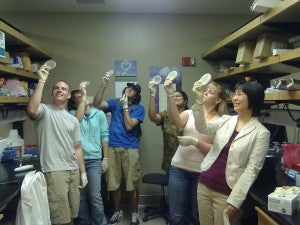
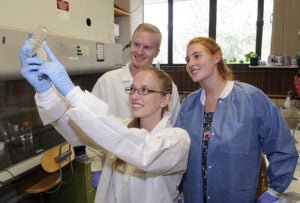
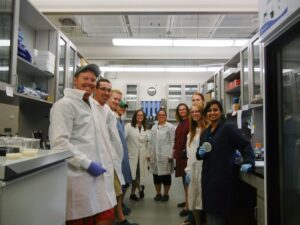
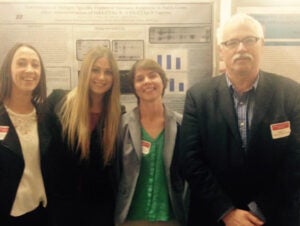
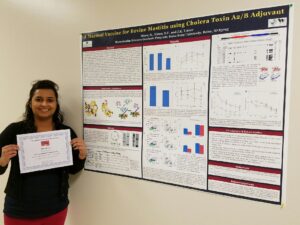
PATENTS/AWARDS
Tinker, J.K. Cholera toxin chimera and its use as a Staph vaccine. U.S. issued patents 8,834,898 (12/16/11), 8,911,748 ( 12/16/11), 8,911,748( 5/17/13), 9,943,582 (8/11/14) and 10,383,933 (8/20/19).
Tinker, J.K. 2012 Winner, Idaho Innovation Award, Early-Stage Innovation. Vaccine for the prevention of staphylocccal infection in humans and dairy cattle.
PUBLICATIONS
Misra, N, Wines, T.F., Knopp, C.L. Hermann, R., Bond, L., Mitchell, B., McGuire, M. and J.K. Tinker. 2018. Immunogenicity of a Staphylococcus aureus-cholera toxin A2/B vaccine for bovine mastitis. Vaccine 36(24):3513-3521.
Misra, N., Pu, S., Holt, D., M. McGuire and J.K. Tinker. 2018. Immunoproteomics to identify Staphylococcus aureus antigens expressed in bovine milk during mastitis. J. Dairy Science 101(7) 6296-6309.
Shretha, N., Bryant, S.L., Thomas, C., Richtsmeier, D., Pu, S., Tinker, J.K., and D. Fologea. 2017. Stochastic sensing of Angiotensin II with lysenin channels. Sci Rep. 7(1)2448.
Misra, N., Wines, T.F., Knopp, C.L., McGuire,M. and J.K. Tinker. 2017.Expression, immunogenicty and variation of IsdA from bovine isolates of Staphylococcus aureus. FEMS Micro Lett. 364(9):fnx082
Belthoff, J., Bernhardt, S., Ball, C., Gregg, M., Johnson, D., Ketterling, R.,Price, E., and J.K. Tinker. (2015). Burrowing owls, Pulex irritans and plague. Vector-Borne and Zoonotic Diseases. Vol 15(9): 556-564.
Tinker, J.K., Yan, J., Knipple, Panayiotou, P. and K. Cornell. (2014). Immunogenicity of a West Nile virus DIII-cholera toxin A2/B chimera after intranasal delivery. Toxins. 6(4):1397-1418.
Arlian, B.A. and J.K. Tinker. (2011) Mucosal Immunization with a Staphylococcus aureus IsdA-cholera toxin A2/B chimera induces antigen specific Th2 type responses in mice. Clinical and Vaccine Immunology. 18(9):1543-1551.
Tinker, J.K., Davis, C.T and B.A. Arlian. (2010) Purification and characterization of Yersinia enterocolitica and Yersinia pestis-cholera toxin A2/B chimeras. Protein Expression and Purification. 74(1):16-23
Feris, K., Otto, C., Tinker, J., Wingett, D., Punnoose, A., Thurber, A., Kongara, M., Sabetian, M., Quinn, B., Hanna, C., and D. Pink (2009) Electrostatic Interactions Affect Nanoparticle-Mediated Toxicity to Gram-Negative Bacterium Pseudomonas aeruginosa PAO1. Langmuir 16:26(6):4429-36.
Tinker, J. K., J. L. Erbe and R. K. Holmes. (2005) Characterization of fluorescent chimeras of cholera toxin and Escherichia coli heat-labile enterotoxins produced by use of the twin arginine translocation system. Infect Immun 73(6): 3627-3635.
Tinker, J. K., J. L. Erbe, et al. (2003) Cholera holotoxin assembly requires a hydrophobic domain at the A-B5 interface: mutational analysis and development of an in vitro assembly system. Infect Immun 71(7): 4093-101.
Yeh, K. S., J. K. Tinker, et al. (2002) FimZ binds the Salmonella typhimurium fimA promoter region and may regulate its own expression with FimY. Microbiol Immunol 46(1): 1-10.
Tinker, J. K., L. S. Hancox, et al. (2001) FimW is a negative regulator affecting type 1 fimbrial expression in Salmonella enterica serovar typhimurium. J Bacteriol 183(2): 435-42.
Tinker, J. K. and S. Clegg (2001) Control of FimY translation and type 1 fimbrial production by the arginine tRNA encoded by fimU in Salmonella enterica serovar Typhimurium. Mol Microbiol 40(3): 757-68.
Tinker, J. K. and S. Clegg (2000) Characterization of FimY as a coactivator of type 1 fimbrial expression in Salmonella enterica serovar Typhimurium. Infect Immun 68(6): 3305-13.
In this video, learn about the kind of work Juliette Tinker and her students perform in the lab. A video transcript is also available.